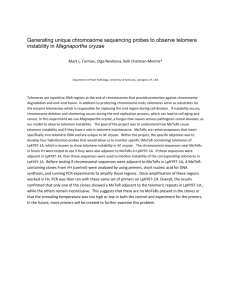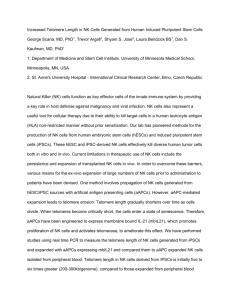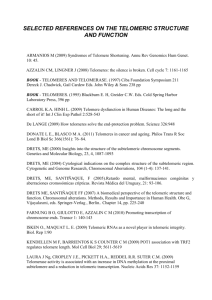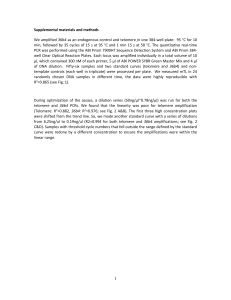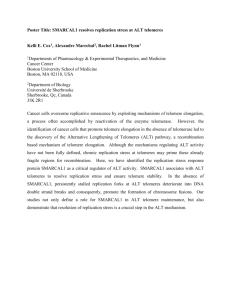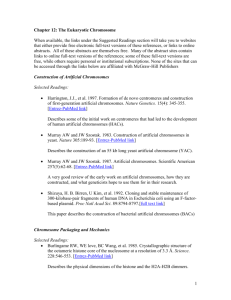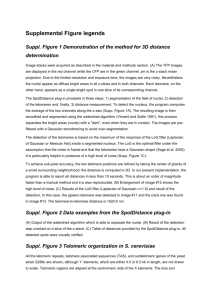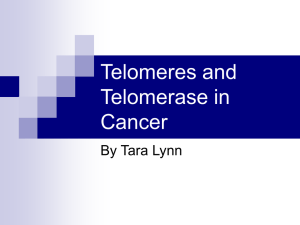knowledge, no published evidence, suggests that
advertisement
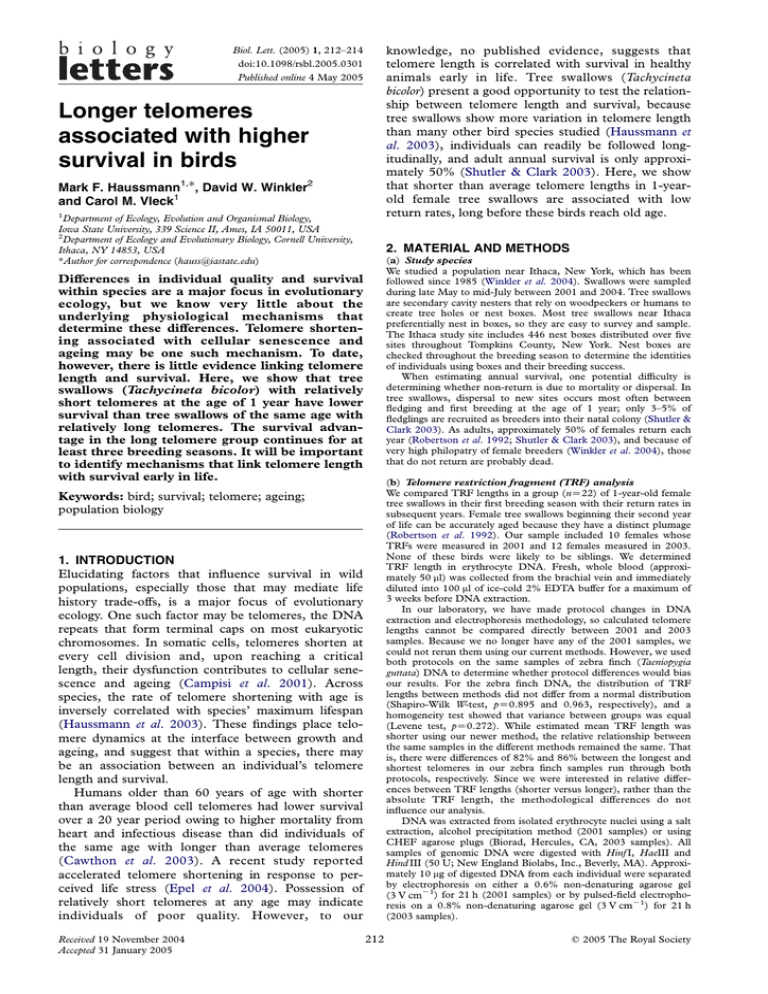
knowledge, no published evidence, suggests that telomere length is correlated with survival in healthy animals early in life. Tree swallows (Tachycineta bicolor) present a good opportunity to test the relationship between telomere length and survival, because tree swallows show more variation in telomere length than many other bird species studied (Haussmann et al. 2003), individuals can readily be followed longitudinally, and adult annual survival is only approximately 50% (Shutler & Clark 2003). Here, we show that shorter than average telomere lengths in 1-yearold female tree swallows are associated with low return rates, long before these birds reach old age. Biol. Lett. (2005) 1, 212–214 doi:10.1098/rsbl.2005.0301 Published online 4 May 2005 Longer telomeres associated with higher survival in birds Mark F. Haussmann1,*, David W. Winkler2 and Carol M. Vleck1 1 Department of Ecology, Evolution and Organismal Biology, Iowa State University, 339 Science II, Ames, IA 50011, USA 2 Department of Ecology and Evolutionary Biology, Cornell University, Ithaca, NY 14853, USA *Author for correspondence (hauss@iastate.edu) 2. MATERIAL AND METHODS (a) Study species We studied a population near Ithaca, New York, which has been followed since 1985 (Winkler et al. 2004). Swallows were sampled during late May to mid-July between 2001 and 2004. Tree swallows are secondary cavity nesters that rely on woodpeckers or humans to create tree holes or nest boxes. Most tree swallows near Ithaca preferentially nest in boxes, so they are easy to survey and sample. The Ithaca study site includes 446 nest boxes distributed over five sites throughout Tompkins County, New York. Nest boxes are checked throughout the breeding season to determine the identities of individuals using boxes and their breeding success. When estimating annual survival, one potential difficulty is determining whether non-return is due to mortality or dispersal. In tree swallows, dispersal to new sites occurs most often between fledging and first breeding at the age of 1 year; only 3–5% of fledglings are recruited as breeders into their natal colony (Shutler & Clark 2003). As adults, approximately 50% of females return each year (Robertson et al. 1992; Shutler & Clark 2003), and because of very high philopatry of female breeders (Winkler et al. 2004), those that do not return are probably dead. Differences in individual quality and survival within species are a major focus in evolutionary ecology, but we know very little about the underlying physiological mechanisms that determine these differences. Telomere shortening associated with cellular senescence and ageing may be one such mechanism. To date, however, there is little evidence linking telomere length and survival. Here, we show that tree swallows (Tachycineta bicolor) with relatively short telomeres at the age of 1 year have lower survival than tree swallows of the same age with relatively long telomeres. The survival advantage in the long telomere group continues for at least three breeding seasons. It will be important to identify mechanisms that link telomere length with survival early in life. (b) Telomere restriction fragment (TRF) analysis We compared TRF lengths in a group (nZ22) of 1-year-old female tree swallows in their first breeding season with their return rates in subsequent years. Female tree swallows beginning their second year of life can be accurately aged because they have a distinct plumage (Robertson et al. 1992). Our sample included 10 females whose TRFs were measured in 2001 and 12 females measured in 2003. None of these birds were likely to be siblings. We determined TRF length in erythrocyte DNA. Fresh, whole blood (approximately 50 ml) was collected from the brachial vein and immediately diluted into 100 ml of ice-cold 2% EDTA buffer for a maximum of 3 weeks before DNA extraction. In our laboratory, we have made protocol changes in DNA extraction and electrophoresis methodology, so calculated telomere lengths cannot be compared directly between 2001 and 2003 samples. Because we no longer have any of the 2001 samples, we could not rerun them using our current methods. However, we used both protocols on the same samples of zebra finch (Taeniopygia guttata) DNA to determine whether protocol differences would bias our results. For the zebra finch DNA, the distribution of TRF lengths between methods did not differ from a normal distribution (Shapiro-Wilk W-test, pZ0.895 and 0.963, respectively), and a homogeneity test showed that variance between groups was equal (Levene test, pZ0.272). While estimated mean TRF length was shorter using our newer method, the relative relationship between the same samples in the different methods remained the same. That is, there were differences of 82% and 86% between the longest and shortest telomeres in our zebra finch samples run through both protocols, respectively. Since we were interested in relative differences between TRF lengths (shorter versus longer), rather than the absolute TRF length, the methodological differences do not influence our analysis. DNA was extracted from isolated erythrocyte nuclei using a salt extraction, alcohol precipitation method (2001 samples) or using CHEF agarose plugs (Biorad, Hercules, CA, 2003 samples). All samples of genomic DNA were digested with Hinf I, HaeIII and Hind III (50 U; New England Biolabs, Inc., Beverly, MA). Approximately 10 mg of digested DNA from each individual were separated by electrophoresis on either a 0.6% non-denaturing agarose gel (3 V cmK1) for 21 h (2001 samples) or by pulsed-field electrophoresis on a 0.8% non-denaturing agarose gel (3 V cmK1) for 21 h (2003 samples). Keywords: bird; survival; telomere; ageing; population biology 1. INTRODUCTION Elucidating factors that influence survival in wild populations, especially those that may mediate life history trade-offs, is a major focus of evolutionary ecology. One such factor may be telomeres, the DNA repeats that form terminal caps on most eukaryotic chromosomes. In somatic cells, telomeres shorten at every cell division and, upon reaching a critical length, their dysfunction contributes to cellular senescence and ageing (Campisi et al. 2001). Across species, the rate of telomere shortening with age is inversely correlated with species’ maximum lifespan (Haussmann et al. 2003). These findings place telomere dynamics at the interface between growth and ageing, and suggest that within a species, there may be an association between an individual’s telomere length and survival. Humans older than 60 years of age with shorter than average blood cell telomeres had lower survival over a 20 year period owing to higher mortality from heart and infectious disease than did individuals of the same age with longer than average telomeres (Cawthon et al. 2003). A recent study reported accelerated telomere shortening in response to perceived life stress (Epel et al. 2004). Possession of relatively short telomeres at any age may indicate individuals of poor quality. However, to our Received 19 November 2004 Accepted 31 January 2005 212 q 2005 The Royal Society Long telomeres and survival in birds 3. RESULTS Of the 22 1-year-olds sampled in this study, 64% (14 individuals) returned as 2-year-olds. For the 10 birds from 2001, 40% of 2-year-olds returned as 3-year-olds and 25% of 3-year-olds returned as 4-year-olds. Overall, these annual survival rates agree with the 50% adult survival estimated across all adult ages for tree swallows (Shutler & Clark 2003). Ten of eleven 1-year-old females with TRFs in the top two quartiles returned in the second year, whereas only 4 of 11 with TRFs in the bottom two quartiles returned ( pZ0.012, figure 1). First-year birds with the longest TRFs (top quartile) were five times more likely than those with the shortest TRFs (bottom 25%) to return as 2-year-olds. For the 2001 sample, return rates continued to diverge in subsequent years, and individuals with longer TRFs had a higher survival probability than those individuals with shorter TRFs ( pZ0.010, figure 1). The mean lifespan predicted from the survival analysis for birds with the shortest TRFs was 1.2 years, while for those with the longest TRFs, it was 3.5 years (Tukey’s HSD; p!0.05, figure 2). Distributions within the quartile did not differ between the 2001 and 2003 birds (c2; pO0.25). 4. DISCUSSION This is the first study to show that telomere length in a free-living animal is associated with survival. Telomere length provides information on the replicative capacity of a tissue, and short telomere lengths may reflect the depleted ability of a tissue to respond to damage and disease (Campisi et al. 2001). For example, the massive proliferative potential of T cells is the foundation of the adaptive immune response, but the number of divisions that cells can undergo is closely linked to telomere length (Lord et al. 2002). Telomeres from human lymphocytes in vivo show a progressive decrease with donor age, and memory T cells have reduced proliferative capacity and shorter telomeres compared with naive T cells, resulting in a decline in immune response with age (Rufer et al. 1998). Previous work in humans and Caenorhabditis elegans has shown that, late in life, individuals possessing long telomeres have higher survival than those Biol. Lett. (2005) percentage returning (c) Statistical analysis In each sample year, we classified birds into four groups based on their TRF length quartiles. Birds in the top 25% have the longest TRFs, and birds in the bottom 25% have the shortest TRFs. Data from both sample years were combined to construct survival curves, so that survival of females in different TRF length quartiles at 1 year of age could be compared. For 2003 birds, we do not know the future survival of the seven females who survived to 2004, so these individuals were right censored. For the 2001 birds, we followed survival for 3 years. We used univariate survival analysis with a Wilcoxon rank test to assess differences between survival curves. Fisher’s exact tests were used to assess differences between return rates in the short and long TRF groups. 213 1.5 4.5 120 100 80 60 40 20 0 0.5 1.0 2.0 2.5 3.0 age (years) 3.5 4.0 Figure 1. Data are plotted as survival curves. Survival of 1-year-old female tree swallows with telomeres in the top quartile (black circles), second quartile (dark grey circles), third quartile (medium grey triangles), or bottom quartile (light grey triangles) of the TRF length distribution in all birds (solid lines) and in those birds sampled in 2001 and then followed through 2004 (hatched lines). 5.0 b 4.5 estimated lifespan (years) All gels were hybridized with 32P-labelled (C3TA2)4 oligonucleotides and TRFs were quantified using densitometry (IMAGEQUANT v. 1.2 and TELOMETRIC) to determine the position and strength of the radioactive signal in each of the lanes, as previously described (Haussmann & Vleck 2002). M. F. Haussmann and others 4.0 a,b 3.5 3.0 2.5 2.0 a a 1.5 1.0 0.5 0 bottom quartile 3rd quartile 2nd quartile top quartile TRF length quartile Figure 2. The mean lifespan based on survival analysis of 1-year-old female tree swallows as a function of telomere length quartiles. Means and 95% confidence intervals (represented by error bars) with different superscripts differ ( p!0.05). with relatively short telomeres (Cawthon et al. 2003; Joeng et al. 2004). In C. elegans, the effect of telomere length on lifespan was examined by overexpressing HRP-1, a telomere binding protein, which is involved in gradually lengthening telomeres over time. The worms with longer telomeres lived longer and were more resistant to heat stress than those with shorter telomeres ( Joeng et al. 2004). While the specific benefit of long telomeres is unknown, one possibility is that they may provide individuals with more replicative potential in the face of a stressful environment. Our study is unique in that it reports a telomererelated survival difference in young individuals. There is abundant variation in tree swallow telomere length within an age class; some 1-year-olds have telomeres as short as 7-year-olds’ (Haussmann et al. 2003), but the source of this variation is unknown. Both genetics and environment probably play a role in determining 214 M. F. Haussmann and others Long telomeres and survival in birds the telomere length of an individual. Studies in human twins report that telomere lengths have heritabilities close to 75% (Slagboom et al. 1994; Jeanclos et al. 2000). For tree swallows, estimated heritability of telomere length prior to fledging is 87%, based on (assumed) full sibling relationships (M. F. Haussmann, D. W. Winkler and C. M. Vleck, unpublished data). This suggests that the initial lengths of an individual’s telomeres are in part dependent on the telomere lengths of their parents’ germ cells. Environmental factors could also contribute to variation in telomere lengths of these adults. Telomeres shorten throughout life, but the most rapid shortening occurs at young ages (Frenck et al. 1998; Hall et al. 2004). European shag nestlings (Phalacrocorax aristotelis) with relatively rapid growth rates show more telomere loss than nestlings with relatively normal growth rates (Hall et al. 2004). Young rats (Rattus norvegicus) displaying postnatal catch-up growth had poorer long-term survival and shorter telomeres than rats with normal growth ( Jennings et al. 1999). In addition, oxidative damage accelerates the ageing process, and recently, free radicals have been shown to contribute to telomere shortening (Von Zglinicki et al. 2000). In swallows, the short telomeres and high mortality of some birds may result from higher levels of oxidative damage. These data suggest that both genetics and environment may impact telomere length and telomere shortening rates, but we do not know currently whether shorter telomeres are simply symptomatic or play a causal role in reduced survival. Regardless, our data suggest that possession of long telomeres is associated with an individual advantage early in adulthood that increases probability of survival, and thus, that telomere lengths in young animals may be predictive of future survival rates. We are now tracking the survival of 100 1-year-old females with known TRF lengths to test this hypothesis further and explore the mechanisms that link survival and telomere length. We thank David Vleck and Daniel Hanley for assistance in the field, Noah Hamm for assistance with demographic data, and Dean Adams, Anne Bronikowski and David Vleck for helpful comments. This work was supported in part by an American Ornithologists’ Union research award to M.F.H., NIH grant RO3-AG022207 to C.M.V., and NSF grant IBN-013437 to D.W.W. Campisi, J., Kim, S. H., Lim, C. S. & Rubio, M. 2001 Cellular senescence, cancer and aging: the telomere connection. Exp. Gerontol. 36, 1619–1637. (doi:10.1016/ S0531-5565(01)00160-7) Cawthon, R. M., Smith, K. R., O’Brien, E., Sivatchenko, A. & Kerber, R. A. 2003 Association between telomere length in blood and mortality in people aged 60 years or older. Lancet 361, 393–395. (doi:10.1016/S0140-6736 (03)12384-7) Biol. Lett. (2005) Epel, E. S., Blackburn, E. H., Lin, J., Dhabhar, F. S., Adler, N. E., Morrow, J. D. & Cawthon, R. M. 2004 Accelerated telomere shortening in response to life stress. Proc. Natl Acad. Sci. USA 101, 17 312–17 315. Frenck, R. W., Blackburn, E. H. & Shannon, K. M. 1998 The rate of telomere sequence loss in human leukocytes varies with age. Proc. Natl Acad. Sci. USA 95, 5607–5610. (doi:10.1073/pnas.95.10.5607) Hall, M. E., Nasir, L., Daunt, F., Gault, E. A., Croxall, J. P., Wanless, S. & Monaghan, P. 2004 Telomere loss in relation to age and early environment in long-lived birds. Proc. R. Soc. B 271, 1571–1576. (doi:10.1098/ rspb.2004.2691) Haussmann, M. F. & Vleck, C. M. 2002 Telomere length provides a new technique for aging animals. Oecologia 130, 325–328. (doi:10.1007/s00442-001-0827-y) Haussmann, M. F., Winkler, D. W., O’Reilly, K. M., Huntington, C. E., Nisbet, I. C. T. & Vleck, C. M. 2003 Telomeres shorten more slowly in long-lived birds and mammals than in short-lived ones. Proc. R. Soc. B 270, 1387–1392. (doi:10.1098/rspb.2003:2385Þ Jeanclos, E., Schork, N. J., Kyvik, K. O., Kimura, M., Skurnick, J. H. & Aviv, A. 2000 Telomere length inversely correlates with pulse pressure and is highly familial. Hypertension 36, 195–200. Jennings, B. J., Ozanne, S. E., Dorling, M. W. & Hales, C. N. 1999 Early growth determines longevity in male rats and may be related to telomere shortening in the kidney. FEBS Lett. 448, 4–8. (doi:10.1016/S0014-5793 (99)00336-1) Joeng, K. S., Song, E. J., Lee, K. J. & Lee, J. 2004 Long lifespan in worms with long telomeric DNA. Nature Genet. 36, 607–611. (doi:10.1038/ng1356) Lord, J. M., Akbar, A. N. & Kipling, D. 2002 Telomerebased therapy for immunosenescence. Trends Immunol. 23, 175–176. (doi:10.1016/S1471-4906(02)02170-1) Robertson, R. J., Stutchbury, B. J. & Cohen, R. R. 1992 Tree swallow. In The birds of North America (ed. A. Poole, P. Stettenheim & F. Gill), pp. 1–28. Philadelphia: The Academy of Natural Sciences of Philadelphia. Rufer, N., Dragowska, W., Thornbury, G., Roosnek, E. & Lansdorp, P. M. 1998 Telomere length dynamics in human lymphocyte subpopulations measured by flow cytometry. Nature Biotechnol. 16, 743–747. (doi:10.1038/ nbt0898-743) Shutler, D. & Clark, R. G. 2003 Causes and consequences of tree swallow (Tachycineta bicolor) dispersal in Saskatchewan. Auk 120, 619–631. Slagboom, P. E., Droog, S. & Boomsma, D. I. 1994 Genetic determination of telomere size in humans: a twin study of three age groups. Am. J. Hum. Genet. 55, 876–882. Von Zglinicki, T., Pilger, R. & Sitte, N. 2000 Accumulation of single-strand breaks is the major cause of telomere shortening in human fibroblasts. Free Radic. Biol. Med. 28, 64–74. Winkler, D. W., Wrege, P. H., Allen, P. E., Kast, T. L., Senesac, P., Wasson, M. F., Llambias, P. E., Ferretti, V. & Sullivan, P. J. 2004 Breeding dispersal and philopatry in the tree swallow. Condor 107, 768–776. The supplementary Electronic Appendix is available at http://dx. doi.org/10.1098/rsbl.2005.0301 or via http://www.journals.royalsoc. ac.uk.
